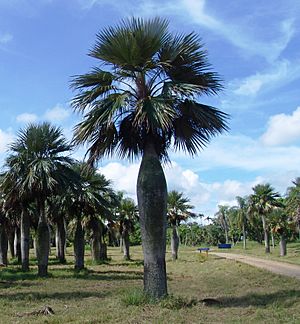Palma barrigona facts for kids
Quick facts for kids Palma barrigona |
|
|---|---|
 |
|
| Conservation status | |
| Scientific classification | |
| Genus: |
Colpothrinax
|
| Species: |
wrightii
|
| Synonyms | |
|
Pritchardia wrightii |
|
The Colpothrinax wrightii, often called the palma barrigona, is a special kind of flowering plant. It belongs to the Arecaceae family, which is the scientific name for palms. This unique palm tree is found only in Cuba, making it an endemic species. This means it naturally grows nowhere else in the world!
Contents
What is the Palma Barrigona?
The palma barrigona is a fascinating palm tree known for its distinctive shape. Its name, "barrigona," means "big-bellied" in Spanish. This refers to its trunk, which often swells in the middle, looking like a potbelly. It's a tall tree that can reach impressive heights.
Where Does it Live?
This palm tree is native to Cuba, a large island in the Caribbean Sea. It grows in specific parts of Cuba, often in sandy or rocky soils. These areas can be quite dry, showing how tough and adaptable this palm is. Its natural home is an important part of its identity.
What Does it Look Like?
The palma barrigona has a smooth, gray trunk that gets wider in the middle. This "belly" is what makes it so easy to recognize. At the top of the trunk, it has a crown of large, fan-shaped leaves. These leaves are green and can spread out widely, giving the tree a majestic look. The flowers are small and grow in clusters. Later, they turn into small, round fruits.
Why is it Special?
This palm is special because of its unique appearance. The swollen trunk is a natural way for the tree to store water. This helps it survive in dry conditions. It is also an important part of Cuba's natural heritage. Many animals and insects might rely on it for food or shelter. Its beauty also makes it a popular tree for gardens in tropical areas.
Why is it in Danger?
Sadly, the palma barrigona is considered a vulnerable species. This means it faces a high risk of becoming extinct in the wild. One reason for this is habitat loss. Forests where it grows are sometimes cleared for farming or building. Climate change can also affect its growth. Illegal collection of seeds or young plants can also harm its population.
How Can We Help?
Protecting the palma barrigona is important for Cuba's environment. Conservation efforts include protecting its natural habitats. This means setting aside land where the palms can grow safely. Educating people about its importance also helps. Growing these palms in botanical gardens can also help save them. This way, future generations can enjoy this unique "big-bellied" palm.


